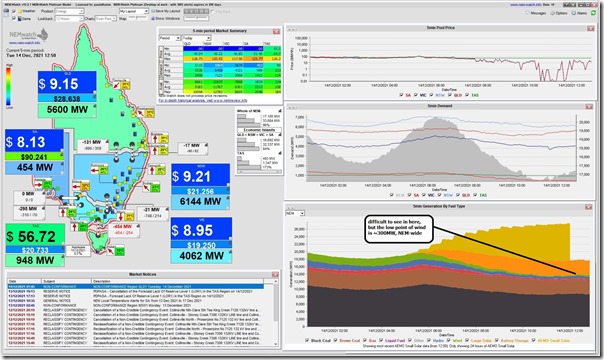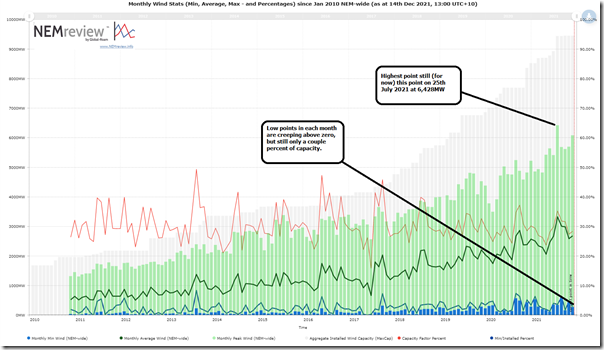We’re putting the finishing touches to the GenInsights21 report for release imminently – but I could not help but note the very low wind production NEM-wide that we’re seeing today (at least in high solar conditions), as seen in this NEMwatch snapshot:
It’s difficult to see, sandwiched between lots of solar and lots of coal, but the low point for wind today is around 300MW only.
Wondering how the monthly low point has trended over the course of NEM history, updated this pre-prepared query we’ve used before (and designed in NEMreview v7, which itself is undergoing some upgrades in recent weeks, following 5MS):
The standout ‘all time maximum’ is still the 6,428MW set on 25th July 2021 at 20:05 – but I would expect that record will be shot in winter 2022, if not before.
The low points are remaining stubbornly around only a couple of percent of installed capacity … but that is slowly easing off zero by virtue of the new capacity. Some months are better than others.




Fortunately most very low wind events happen during the day when as you say solar is increasingly covering them. There are some occurring at night which leave a 15 GW gap between hydro + wind and net demand so even if wind is quadrupled over the next 10 years and 3-4 GW of pumped hydro comes on line there is still a fair gap to fill. However moving a lot of non time sensitive demand from nighttime offpeak tariffs which were designed to keep coal plants going to daytime solar sponge tariffs will fill a substantial part of that gap
The era of fixed times for non-time sensitive loads should be dead and buried. The cost of smart control systems are low now and we should be taking advantage of this. This means a much better match between production of RE and loads.
The problem of low-wind periods is never going to go away because when the CP is down to 2 or 3% that is practically zero compared with the demand in the grid regardless of installed capacity. This was clear years ago, as soon as we knew that the 2012 study of wind droughts across the NEM published by Paul Miskelly was not going to be superseded by more recent data. Prolonged wind droughts can occur between sunset and sunrise as well and it doesn’t matter if these events are rare, because until we have several more Snowy schemes or ample nuclear power the lights will go out bigtime sooner or later, and how often do we want that to happen?
The crux of the problem is the “gap in the flood protection wall” effect. Build the high parts of the wall higher and increase the average height but the water will still come in through the gaps.
https://www.riteon.org.au/netzero-casualties/#217